Bupropion Hydrochloride
These highlights do not include all the information needed to use BUPROPION HYDROCHLORIDE EXTENDED-RELEASE TABLETS (SR) safely and effectively. See full prescribing information for BUPROPION HYDROCHLORIDE EXTENDED-RELEASE TABLETS (SR). BUPROPION HYDROCHLORIDE extended-release tablets (SR), for oral use Initial U.S. Approval: 1985
161637d2-bc9d-4a2b-ad1f-6cc39ffd69ce
HUMAN PRESCRIPTION DRUG LABEL
Mar 16, 2023
Radha Pharmaceuticals, Inc.
DUNS: 117634222
Products 3
Detailed information about drug products covered under this FDA approval, including NDC codes, dosage forms, ingredients, and administration routes.
bupropion hydrochloride
Product Details
FDA regulatory identification and product classification information
FDA Identifiers
Product Classification
Product Specifications
INGREDIENTS (15)
bupropion hydrochloride
Product Details
FDA regulatory identification and product classification information
FDA Identifiers
Product Classification
Product Specifications
INGREDIENTS (16)
bupropion hydrochloride
Product Details
FDA regulatory identification and product classification information
FDA Identifiers
Product Classification
Product Specifications
INGREDIENTS (15)
Drug Labeling Information
PACKAGE LABEL.PRINCIPAL DISPLAY PANEL
Package/Label Display Panel
NDC 77771-174-60
Twice-A-Day (After Initial Titration)
buPROPion HCl
** Extended-Release**
** Tablets, USP (SR)**
100 mg
PHARMACIST: Dispense the accompanying
** Medication Guide to each patient.**
WARNING: Do not use in combination
** with ZYBAN****®**** or any other medicines**
** that contain bupropion hydrochloride.**
60 Tablets Rx Only
Radha Pharmaceuticals Inc.
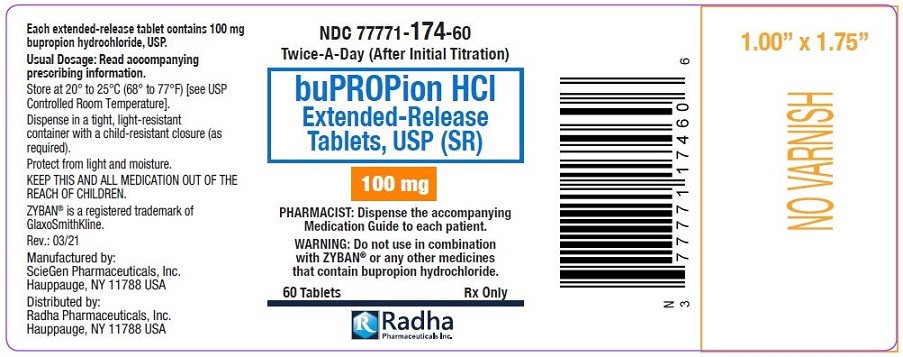
NDC 77771-174-05
Twice-A-Day (After Initial Titration)
buPROPion HCl
** Extended-Release**
** Tablets, USP (SR)**
100 mg
PHARMACIST: Dispense the accompanying
** Medication Guide to each patient.**
WARNING: Do not use in combination
** with ZYBAN****®**** or any other medicines**
** that contain bupropion hydrochloride.**
500 Tablets Rx Only
Radha Pharmaceuticals Inc.
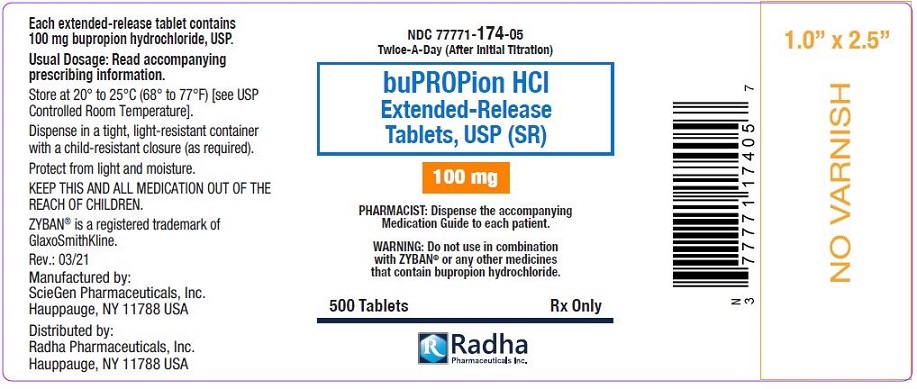
NDC 77771-175-60
Twice-A-Day (After Initial Titration)
buPROPion HCl
** Extended-Release**
** Tablets, USP (SR)**
150 mg
PHARMACIST: Dispense the accompanying
** Medication Guide to each patient.**
WARNING: Do not use in combination
** with ZYBAN****®**** or any other medicines**
** that contain bupropion hydrochloride.**
60 Tablets Rx Only
Radha Pharmaceuticals Inc.
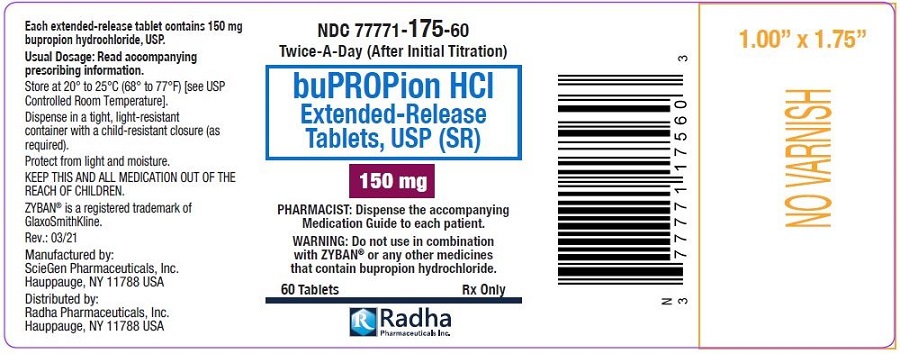
NDC 77771-175-05
Twice-A-Day (After Initial Titration)
buPROPion HCl
** Extended-Release**
** Tablets, USP (SR)**
150 mg
PHARMACIST: Dispense the accompanying
** Medication Guide to each patient.**
WARNING: Do not use in combination
** with ZYBAN****®**** or any other medicines**
** that contain bupropion hydrochloride.**
500 Tablets Rx Only
Radha Pharmaceuticals Inc.
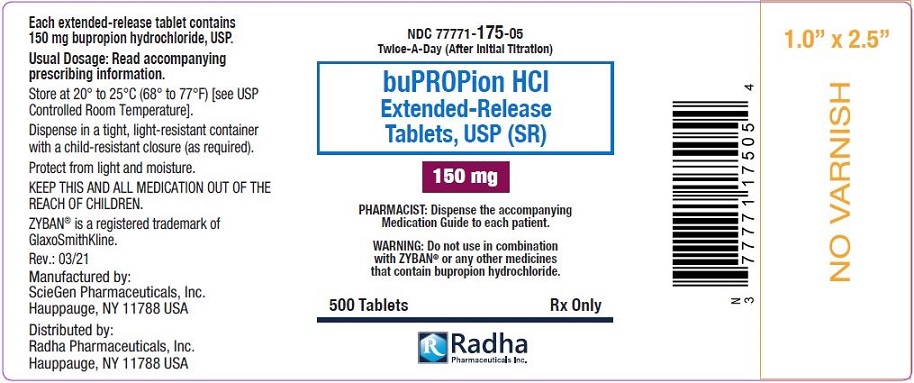
NDC 77771-176-60
Twice-A-Day (After Initial Titration)
buPROPion HCl
Extended-Release
** Tablets, USP (SR)**
200 mg
PHARMACIST: Dispense the accompanying
** Medication Guide to each patient.**
WARNING: Do not use in combination
** with ZYBAN****®**** or any other medicines**
** that contain bupropion hydrochloride.**
60 Tablets Rx Only
Radha Pharmaceuticals Inc.
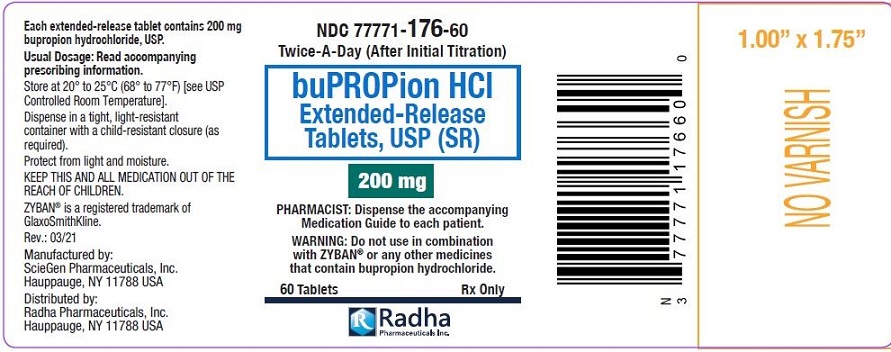
WARNINGS AND PRECAUTIONS SECTION
5 WARNINGS AND PRECAUTIONS
5.1 Suicidal Thoughts and Behaviors in Children, Adolescents, and Young
Adults
Patients with MDD, both adult and pediatric, may experience worsening of their depression and/or the emergence of suicidal ideation and behavior (suicidality) or unusual changes in behavior, whether or not they are taking antidepressant medications, and this risk may persist until significant remission occurs. Suicide is a known risk of depression and certain other psychiatric disorders, and these disorders themselves are the strongest predictors of suicide. There has been a long-standing concern that antidepressants may have a role in inducing worsening of depression and the emergence of suicidality in certain patients during the early phases of treatment.
Pooled analyses of short-term placebo-controlled trials of antidepressant drugs (selective serotonin reuptake inhibitors [SSRIs] and others) show that these drugs increase the risk of suicidal thinking and behavior (suicidality) in children, adolescents, and young adults (ages 18 to 24) with MDD and other psychiatric disorders. Short-term clinical trials did not show an increase in the risk of suicidality with antidepressants compared with placebo in adults beyond age 24; there was a reduction with antidepressants compared with placebo in adults aged 65 and older.
The pooled analyses of placebo-controlled trials in children and adolescents with MDD, obsessive compulsive disorder (OCD), or other psychiatric disorders included a total of 24 short term trials of 9 antidepressant drugs in over 4,400 subjects. The pooled analyses of placebo-controlled trials in adults with MDD or other psychiatric disorders included a total of 295 short-term trials (median duration of 2 months) of 11 antidepressant drugs in over 77,000 subjects. There was considerable variation in risk of suicidality among drugs, but a tendency toward an increase in the younger subjects for almost all drugs studied. There were differences in absolute risk of suicidality across the different indications, with the highest incidence in MDD. The risk differences (drug vs. placebo), however, were relatively stable within age strata and across indications. These risk differences (drug-placebo difference in the number of cases of suicidality per 1,000 subjects treated) are provided in Table 1.
|
Table 1. Risk Differences in the Number of Suicidality Cases by Age Group in the Pooled Placebo-Controlled Trials of Antidepressants in Pediatric and Adult Subjects | |
|
Age Range |
Drug-Placebo Difference in Number of Cases of Suicidality per 1,000 Subjects Treated |
|
Increases Compared With Placebo | |
|
<18 |
14 additional cases |
|
18 to 24 |
5 additional cases |
|
Decreases Compared With Placebo | |
|
25 to 64 |
1 fewer case |
|
≥65 |
6 fewer cases |
No suicides occurred in any of the pediatric trials. There were suicides in the adult trials, but the number was not sufficient to reach any conclusion about drug effect on suicide.
It is unknown whether the suicidality risk extends to longer-term use, i.e., beyond several months. However, there is substantial evidence from placebo- controlled maintenance trials in adults with depression that the use of antidepressants can delay the recurrence of depression.
All patients being treated with antidepressants for any indication should be monitored appropriately and observed closely for clinical worsening, suicidality, and unusual changes in behavior, especially during the initial few months of a course of drug therapy, or at times of dose changes, either increases or decreases**[seeBoxed Warning]****.**
The following symptoms, anxiety, agitation, panic attacks, insomnia, irritability, hostility, aggressiveness, impulsivity, akathisia (psychomotor restlessness), hypomania, and mania, have been reported in adult and pediatric patients being treated with antidepressants for major depressive disorder as well as for other indications, both psychiatric and nonpsychiatric. Although a causal link between the emergence of such symptoms and either the worsening of depression and/or the emergence of suicidal impulses has not been established, there is concern that such symptoms may represent precursors to emerging suicidality.
Consideration should be given to changing the therapeutic regimen, including possibly discontinuing the medication, in patients whose depression is persistently worse, or who are experiencing emergent suicidality or symptoms that might be precursors to worsening depression or suicidality, especially if these symptoms are severe, abrupt in onset, or were not part of the patient’s presenting symptoms.
Families and caregivers of patients being treated with antidepressants for MDD or other indications, both psychiatric and nonpsychiatric, should be alerted about the need to monitor patients for the emergence of agitation, irritability, unusual changes in behavior, and the other symptoms described above, as well as the emergence of suicidality, and to report such symptoms immediately to healthcare providers. Such monitoring should include daily observation by families and caregivers. Prescriptions for bupropion hydrochloride extended-release tablets (SR) should be written for the smallest quantity of tablets consistent with good patient management, in order to reduce the risk of overdose.
5.2 Neuropsychiatric Adverse Events and Suicide Risk in Smoking Cessation
Treatment
Bupropion hydrochloride extended-release tablets (SR) is not approved for smoking cessation treatment; however, it contains the same active ingredient as the smoking cessation medication ZYBAN. Serious neuropsychiatric adverse events have been reported in patients taking bupropion for smoking cessation. These postmarketing reports have included changes in mood (including depression and mania), psychosis, hallucinations, paranoia, delusions, homicidal ideation, aggression, hostility, agitation, anxiety, and panic, as well as suicidal ideation, suicide attempt, and completed suicide [see Adverse Reactions ( 6.2)] . Some patients who stopped smoking may have been experiencing symptoms of nicotine withdrawal, including depressed mood. Depression, rarely including suicidal ideation, has been reported in smokers undergoing a smoking cessation attempt without medication. However, some of these adverse events occurred in patients taking bupropion who continued to smoke.
Neuropsychiatric adverse events occurred in patients without and with pre- existing psychiatric disease; some patients experienced worsening of their psychiatric illnesses. Observe patients for the occurrence of neuropsychiatric adverse events. Advise patients and caregivers that the patient should stop taking bupropion hydrochloride extended-release tablets and contact a healthcare provider immediately if agitation, depressed mood, or changes in behavior or thinking that are not typical for the patient are observed, or if the patient develops suicidal ideation or suicidal behavior. In many postmarketing cases, resolution of symptoms after discontinuation of bupropion was reported. However, the symptoms persisted in some cases; therefore, ongoing monitoring and supportive care should be provided until symptoms resolve.
5.3 Seizure
Bupropion hydrochloride extended-release tablets (SR) can cause seizure. The risk of seizure is dose-related. The dose should not exceed 400 mg per day. Increase the dose gradually. Discontinue bupropion hydrochloride extended- release tablets (SR) and do not restart treatment if the patient experiences a seizure.
The risk of seizures is also related to patient factors, clinical situations, and concomitant medications that lower the seizure threshold. Consider these risks before initiating treatment with bupropion hydrochloride extended- release tablets (SR). Bupropion hydrochloride extended-release tablets (SR) are contraindicated in patients with a seizure disorder, current or prior diagnosis of anorexia nervosa or bulimia, or undergoing abrupt discontinuation of alcohol, benzodiazepines, barbiturates, and antiepileptic drugs [see Contraindications ( 4), Drug Interactions ( 7.3)] . The following conditions can also increase the risk of seizure: severe head injury; arteriovenous malformation; CNS tumor or CNS infection; severe stroke; concomitant use of other medications that lower the seizure threshold (e.g., other bupropion products, antipsychotics, tricyclic antidepressants, theophylline, and systemic corticosteroids); metabolic disorders (e.g., hypoglycemia, hyponatremia, severe hepatic impairment, and hypoxia); use of illicit drugs (e.g., cocaine); or abuse or misuse of prescription drugs such as CNS stimulants. Additional predisposing conditions include diabetes mellitus treated with oral hypoglycemic drugs or insulin; use of anorectic drugs; and excessive use of alcohol, benzodiazepines, sedative/hypnotics, or opiates.
Incidence of Seizure with Bupropion Use:
When bupropion hydrochloride extended-release tablets (SR) are dosed up to 300 mg per day, the incidence of seizure is approximately 0.1% (1/1,000) and increases to approximately 0.4% (4/1,000) at the maximum recommended dose of 400 mg/day.
The risk of seizure can be reduced if the dose of bupropion hydrochloride extended-release tablets (SR) does not exceed 400 mg/day, given as 200 mg twice daily, and the titration rate is gradual.
5.4 Hypertension
Treatment with bupropion hydrochloride extended-release tablets (SR) can result in elevated blood pressure and hypertension. Assess blood pressure before initiating treatment with bupropion hydrochloride extended-release tablets (SR), and monitor periodically during treatment. The risk of hypertension is increased if bupropion hydrochloride extended-release tablets (SR) are used concomitantly with MAOIs or other drugs that increase dopaminergic or noradrenergic activity [see Contraindications ( 4)].
Data from a comparative trial of the sustained-release formulation of bupropion HCl, nicotine transdermal system (NTS), the combination of sustained-release bupropion plus NTS, and placebo as an aid to smoking cessation suggest a higher incidence of treatment-emergent hypertension in patients treated with the combination of sustained-release bupropion and NTS. In this trial, 6.1% of subjects treated with the combination of sustained- release bupropion and NTS had treatment-emergent hypertension compared with 2.5%, 1.6%, and 3.1% of subjects treated with sustained-release bupropion, NTS, and placebo, respectively. The majority of these subjects had evidence of pre-existing hypertension. Three subjects (1.2%) treated with the combination of sustained-release bupropion and NTS and 1 subject (0.4%) treated with NTS had study medication discontinued due to hypertension compared with none of the subjects treated with sustained-release bupropion or placebo. Monitoring of blood pressure is recommended in patients who receive the combination of bupropion and nicotine replacement.
In a clinical trial of bupropion immediate-release in MDD subjects with stable congestive heart failure (N = 36), bupropion was associated with an exacerbation of pre-existing hypertension in 2 subjects, leading to discontinuation of bupropion treatment. There are no controlled trials assessing the safety of bupropion in patients with a recent history of myocardial infarction or unstable cardiac disease.
5.5 Activation of Mania/Hypomania
Antidepressant treatment can precipitate a manic, mixed, or hypomanic manic episode. The risk appears to be increased in patients with bipolar disorder or who have risk factors for bipolar disorder. Prior to initiating bupropion hydrochloride extended-release tablets (SR), screen patients for a history of bipolar disorder and the presence of risk factors for bipolar disorder (e.g., family history of bipolar disorder, suicide, or depression). Bupropion hydrochloride extended-release tablets (SR) are not approved for use in treating bipolar depression.
5.6 Psychosis and Other Neuropsychiatric Reactions
Depressed patients treated with bupropion hydrochloride extended-release tablets (SR) have had a variety of neuropsychiatric signs and symptoms, including delusions, hallucinations, psychosis, concentration disturbance, paranoia, and confusion. Some of these patients had a diagnosis of bipolar disorder. In some cases, these symptoms abated upon dose reduction and/or withdrawal of treatment. Instruct patients to contact a healthcare professional if such reactions occur.
5.7 Angle-Closure Glaucoma
The pupillary dilation that occurs following use of many antidepressant drugs including bupropion hydrochloride extended-release tablets (SR) may trigger an angle-closure attack in a patient with anatomically narrow angles who does not have a patent iridectomy.
5.8 Hypersensitivity Reactions
Anaphylactoid/anaphylactic reactions have occurred during clinical trials with bupropion. Reactions have been characterized by pruritus, urticaria, angioedema, and dyspnea requiring medical treatment. In addition, there have been rare, spontaneous postmarketing reports of erythema multiforme, Stevens- Johnson syndrome, and anaphylactic shock associated with bupropion. Instruct patients to discontinue bupropion hydrochloride extended-release tablets (SR) and consult a healthcare provider if they develop an allergic or anaphylactoid/anaphylactic reaction (e.g., skin rash, pruritus, hives, chest pain, edema, and shortness of breath) during treatment.
There are reports of arthralgia, myalgia, fever with rash, and other serum sickness-like symptoms suggestive of delayed hypersensitivity.
- Neuropsychiatric adverse events during smoking cessation: Postmarketing reports of serious or clinically significant neuropsychiatric adverse events have included changes in mood (including depression and mania), psychosis, hallucinations, paranoia, delusions, homicidal ideation, aggression, hostility, agitation, anxiety, and panic, as well as suicidal ideation, suicide attempt, and completed suicide. Observe patients attempting to quit smoking with bupropion for the occurrence of such symptoms and instruct them to discontinue bupropion and contact a healthcare provider if they experience such adverse events. ( 5.2)
- Seizure risk: The risk is dose-related. Can minimize risk by gradually increasing the dose and limiting daily dose to 400 mg. Discontinue if seizure occurs. ( 4, 5.3, 7.3)
- Hypertension: Bupropion hydrochloride extended-release tablets (SR) can increase blood pressure. Monitor blood pressure before initiating treatment and periodically during treatment. ( 5.4)
- Activation of mania/hypomania: Screen patients for bipolar disorder and monitor for these symptoms. ( 5.5)
- Psychosis and other neuropsychiatric reactions: Instruct patients to contact a healthcare professional if such reactions occur. ( 5.6)
- Angle-closure glaucoma: Angle-closure glaucoma has occurred in patients with untreated anatomically narrow angles treated with antidepressants. ( 5.7)
DRUG INTERACTIONS SECTION
7 DRUG INTERACTIONS
7.1 Potential for Other Drugs to Affect Bupropion Hydrochloride Extended-
release Tablets (SR)
Bupropion is primarily metabolized to hydroxybupropion by CYP2B6. Therefore, the potential exists for drug interactions between bupropion hydrochloride extended-release tablets (SR) and drugs that are inhibitors or inducers of CYP2B6.
Inhibitors of CYP2B6
Ticlopidine and Clopidogrel: Concomitant treatment with these drugs can increase bupropion exposure but decrease hydroxybupropion exposure. Based on clinical response, dosage adjustment of bupropion hydrochloride extended- release tablets (SR) may be necessary when coadministered with CYP2B6 inhibitors (e.g., ticlopidine or clopidogrel) [see Clinical Pharmacology ( 12.3)] .
Inducers of CYP2B6
Ritonavir, Lopinavir, and Efavirenz: Concomitant treatment with these drugs can decrease bupropion and hydroxybupropion exposure. Dosage increase of bupropion hydrochloride extended-release tablets (SR) may be necessary when coadministered with ritonavir, lopinavir, or efavirenz [see Clinical Pharmacology ( 12.3)] but should not exceed the maximum recommended dose.
Carbamazepine, Phenobarbital, Phenytoin: While not systematically studied, these drugs may induce the metabolism of bupropion and may decrease bupropion exposure [see Clinical Pharmacology ( 12.3)] . If bupropion is used concomitantly with a CYP inducer, it may be necessary to increase the dose of bupropion, but the maximum recommended dose should not be exceeded.
7.2 Potential for Bupropion Hydrochloride Extended-release Tablets (SR) to
Affect Other Drugs
Drugs Metabolized by CYP2D6
Bupropion and its metabolites (erythrohydrobupropion, threohydrobupropion, hydroxybupropion) are CYP2D6 inhibitors. Therefore, coadministration of bupropion hydrochloride extended-release tablets (SR) with drugs that are metabolized by CYP2D6 can increase the exposures of drugs that are substrates of CYP2D6. Such drugs include certain antidepressants (e.g., venlafaxine, nortriptyline, imipramine, desipramine, paroxetine, fluoxetine, and sertraline), antipsychotics (e.g., haloperidol, risperidone, thioridazine), beta-blockers (e.g., metoprolol), and Type 1C antiarrhythmics (e.g., propafenone and flecainide). When used concomitantly with bupropion hydrochloride extended-release tablets (SR), it may be necessary to decrease the dose of these CYP2D6 substrates, particularly for drugs with a narrow therapeutic index.
Drugs that require metabolic activation by CYP2D6 to be effective (e.g., tamoxifen) theoretically could have reduced efficacy when administered concomitantly with inhibitors of CYP2D6 such as bupropion. Patients treated concomitantly with bupropion hydrochloride extended-release tablets (SR) and such drugs may require increased doses of the drug [see Clinical Pharmacology ( 12.3)] .
Digoxin
Coadministration of bupropion hydrochloride extended-release tablets (SR) with digoxin may decrease plasma digoxin levels. Monitor plasma digoxin levels in patients treated concomitantly with bupropion hydrochloride extended-release tablets (SR) and digoxin [see Clinical Pharmacology ( 12.3)].
7.3 Drugs that Lower Seizure Threshold
Use extreme caution when coadministering bupropion hydrochloride extended- release tablets (SR) with other drugs that lower seizure threshold (e.g., other bupropion products, antipsychotics, antidepressants, theophylline, or systemic corticosteroids). Use low initial doses and increase the dose gradually [see Contraindications ( 4), Warnings and Precautions ( 5.3)] .
7.4 Dopaminergic Drugs (Levodopa and Amantadine)
Bupropion, levodopa, and amantadine have dopamine agonist effects. CNS toxicity has been reported when bupropion was coadministered with levodopa or amantadine. Adverse reactions have included restlessness, agitation, tremor, ataxia, gait disturbance, vertigo, and dizziness. It is presumed that the toxicity results from cumulative dopamine agonist effects. Use caution when administering bupropion hydrochloride extended-release tablets (SR) concomitantly with these drugs.
7.5 Use with Alcohol
In postmarketing experience, there have been rare reports of adverse neuropsychiatric events or reduced alcohol tolerance in patients who were drinking alcohol during treatment with bupropion hydrochloride extended- release tablets (SR). The consumption of alcohol during treatment with bupropion hydrochloride extended-release tablets (SR) should be minimized or avoided.
7.6 MAO Inhibitors
Bupropion inhibits the reuptake of dopamine and norepinephrine. Concomitant use of MAOIs and bupropion is contraindicated because there is an increased risk of hypertensive reactions if bupropion is used concomitantly with MAOIs. Studies in animals demonstrate that the acute toxicity of bupropion is enhanced by the MAO inhibitor phenelzine. At least 14 days should elapse between discontinuation of an MAOI intended to treat depression and initiation of treatment with bupropion hydrochloride extended-release tablets (SR). Conversely, at least 14 days should be allowed after stopping bupropion hydrochloride extended-release tablets (SR) before starting an MAOI antidepressant [see Dosage and Administration ( 2.4, 2.5), Contraindications ( 4)] .
7.7 Drug-Laboratory Test Interactions
False-positive urine immunoassay screening tests for amphetamines have been reported in patients taking bupropion. This is due to lack of specificity of some screening tests. False-positive test results may result even following discontinuation of bupropion therapy. Confirmatory tests, such as gas chromatography/mass spectrometry, will distinguish bupropion from amphetamines.
- CYP2B6 inducers: Dose increase may be necessary if coadministered with CYP2B6 inducers (e.g., ritonavir, lopinavir, efavirenz, carbamazepine, phenobarbital, and phenytoin) based on clinical response, but should not exceed the maximum recommended dose. ( 7.1)
- Drugs metabolized by CYP2D6: Bupropion inhibits CYP2D6 and can increase concentrations of: antidepressants (e.g., venlafaxine, nortriptyline, imipramine, desipramine, paroxetine, fluoxetine, sertraline), antipsychotics (e.g., haloperidol, risperidone, thioridazine), beta-blockers (e.g., metoprolol), and Type 1C antiarrhythmics (e.g., propafenone, flecainide). Consider dose reduction when using with bupropion. ( 7.2)
- Digoxin: May decrease plasma digoxin levels. Monitor digoxin levels. ( 7.2)
- Drugs that lower seizure threshold: Dose bupropion hydrochloride extended-release tablets (SR) with caution. ( 5.3, 7.3)
- Dopaminergic drugs (levodopa and amantadine): CNS toxicity can occur when used concomitantly with bupropion hydrochloride extended-release tablets (SR). ( 7.4)
- MAOIs: Increased risk of hypertensive reactions can occur when used concomitantly with bupropion hydrochloride extended-release tablets (SR). ( 7.6)
- Drug-laboratory test interactions: Bupropion hydrochloride extended-release tablets (SR) can cause false-positive urine test results for amphetamines. ( 7.7)
DOSAGE & ADMINISTRATION SECTION
2 DOSAGE AND ADMINISTRATION
2.1 General Instructions for Use
To minimize the risk of seizure, increase the dose gradually [see Warnings and Precautions ( 5.3)] . Bupropion hydrochloride extended-release tablets (SR) should be swallowed whole and not crushed, divided, or chewed. Bupropion hydrochloride extended-release tablets (SR) may be taken with or without food.
The usual adult target dose for bupropion hydrochloride extended-release tablets (SR) is 300 mg/day, given as 150 mg twice daily. Initiate dosing with 150 mg/day given as a single daily dose in the morning. After 3 days of dosing, the dose may be increased to the 300-mg/day target dose, given as 150 mg twice daily. There should be an interval of at least 8 hours between successive doses. A maximum of 400 mg/day, given as 200 mg twice daily, may be considered for patients in whom no clinical improvement is noted after several weeks of treatment at 300 mg/day. To avoid high peak concentrations of bupropion and/or its metabolites, do not exceed 200 mg in any single dose.
It is generally agreed that acute episodes of depression require several months or longer of antidepressant drug treatment beyond the response in the acute episode. It is unknown whether the dose of bupropion hydrochloride extended-release tablets (SR) needed for maintenance treatment is identical to the dose that provided an initial response. Periodically reassess the need for maintenance treatment and the appropriate dose for such treatment.
2.2 Dose Adjustment in Patients with Hepatic Impairment
In patients with moderate to severe hepatic impairment (Child-Pugh score: 7 to 15), the maximum dose of bupropion hydrochloride extended-release tablets (SR) is 100 mg/day or 150 mg every other day. In patients with mild hepatic impairment (Child-Pugh score: 5 to 6), consider reducing the dose and/or frequency of dosing [see Use in Specific Populations ( 8.7), Clinical Pharmacology ( 12.3)].
2.3 Dose Adjustment in Patients with Renal Impairment
Consider reducing the dose and/or frequency of bupropion hydrochloride extended-release tablets (SR) in patients with renal impairment (Glomerular Filtration Rate [GFR] less than 90 mL/min) [see Use in Specific Populations ( 8.6), Clinical Pharmacology ( 12.3)] .
2.4 Switching a Patient to or from a Monoamine Oxidase Inhibitor (MAOI)
Antidepressant
At least 14 days should elapse between discontinuation of an MAOI intended to treat depression and initiation of therapy with bupropion hydrochloride extended-release tablets (SR). Conversely, at least 14 days should be allowed after stopping bupropion hydrochloride extended-release tablets (SR) before starting an MAOI antidepressant [see Contraindications ( 4), Drug Interactions ( 7.6)] .
2.5 Use of Bupropion Hydrochloride Extended-Release Tablets (SR) with
Reversible MAOIs Such as Linezolid or Methylene Blue
Do not start bupropion hydrochloride extended-release tablets (SR) in a patient who is being treated with a reversible MAOI such as linezolid or intravenous methylene blue. Drug interactions can increase the risk of hypertensive reactions. In a patient who requires more urgent treatment of a psychiatric condition, non-pharmacological interventions, including hospitalization, should be considered [see Contraindications ( 4), Drug Interactions ( 7.6)] .
In some cases, a patient already receiving therapy with bupropion hydrochloride extended-release tablets (SR) may require urgent treatment with linezolid or intravenous methylene blue. If acceptable alternatives to linezolid or intravenous methylene blue treatment are not available and the potential benefits of linezolid or intravenous methylene blue treatment are judged to outweigh the risks of hypertensive reactions in a particular patient, bupropion hydrochloride extended-release tablets (SR) should be stopped promptly, and linezolid or intravenous methylene blue can be administered. The patient should be monitored for 2 weeks or until 24 hours after the last dose of linezolid or intravenous methylene blue, whichever comes first. Therapy with bupropion hydrochloride extended-release tablets (SR) may be resumed 24 hours after the last dose of linezolid or intravenous methylene blue.
The risk of administering methylene blue by non-intravenous routes (such as oral tablets or by local injection) or in intravenous doses much lower than 1 mg/kg with bupropion hydrochloride extended-release tablets (SR) is unclear. The clinician should, nevertheless, be aware of the possibility of a drug interaction with such use [see Contraindications ( 4), Drug Interactions ( 7.6)] .
- Starting dose: 150 mg/day ( 2.1)
- General: Increase dose gradually to reduce seizure risk. ( 2.1, 5.3)
- After 3 days, may increase the dose to 300 mg/day, given as 150 mg twice daily at an interval of at least 8 hours. ( 2.1)
- Usual target dose: 300 mg/day as 150 mg twice daily. ( 2.1)
- Maximum dose: 400 mg/day, given as 200 mg twice daily, for patients not responding to 300 mg/day. ( 2.1)
- Periodically reassess the dose and need for maintenance treatment. ( 2.1)
- Moderate to severe hepatic impairment: 100 mg daily or 150 mg every other day. ( 2.2, 8.7)
- Mild hepatic impairment: Consider reducing the dose and/or frequency of dosing. ( 2.2, 8.7)
- Renal impairment: Consider reducing the dose and/or frequency. ( 2.3, 8.6)
NONCLINICAL TOXICOLOGY SECTION
13 NONCLINICAL TOXICOLOGY
13.1 Carcinogenesis, Mutagenesis, Impairment of Fertility
Lifetime carcinogenicity studies were performed in rats and mice at bupropion doses up to 300 and 150 mg/kg/day, respectively. These doses are approximately 7 and 2 times the MRHD, respectively, on a mg/m 2 basis. In the rat study there was an increase in nodular proliferative lesions of the liver at doses of 100 to 300 mg/kg/day (approximately 2 to 7 times the MRHD on a mg/m 2 basis); lower doses were not tested. The question of whether or not such lesions may be precursors of neoplasms of the liver is currently unresolved. Similar liver lesions were not seen in the mouse study, and no increase in malignant tumors of the liver and other organs was seen in either study.
Bupropion produced a positive response (2 to 3 times control mutation rate) in 2 of 5 strains in the Ames bacterial mutagenicity assay. Bupropion produced an increase in chromosomal aberrations in 1 of 3 in vivo rat bone marrow cytogenetic studies.
There were no effects on male and female fertility when rats were administered oral doses of bupropion up to 300 mg/kg/day (approximately 7 times the MRHD on a mg/m 2 basis) to females prior to mating and either through Day 13 of gestation or through lactation, and to males for 60 days prior to and through mating. However, doses of 200 mg/kg/day (approximately 5 times the MRHD on a mg/m 2 basis) or greater, caused transient ataxia or behavioral changes in adult female rats. There were also no adverse effects on fertility, reproduction, or growth and development of male or female offspring.
